D-Lib Magazine
March/April 2011
Volume 17, Number 3/4
Table of Contents
Resource Sharing in Australia: Find and Get in Trove – Making "Getting" Better
Rose Holley
National Library of Australia
rholley@nla.gov.au
doi:10.1045/march2011-holley
Printer-friendly Version
Abstract
Trove is the Australian discovery service focusing on Australia and Australians, launched at the end of 2009. It has been created and is managed by the National Library of Australia. Trove harvests metadata from over 1,000 Australian libraries and other cultural heritage institutions and organisations, giving the public free access to over 100 million items. A guiding principle of Trove is 'Find and Get'. The first principle to 'find' has been achieved well. A user can find a wealth of information and format types in a single search, aggregated from many sources. The relevance ranking and zoning of results makes finding quick and easy. Therefore, the focus of the Trove team for the latter half of 2010 and into 2011 has been to improve the 'get' options. This article gives an overview of how 'getting' has been improved so far, current work underway, and ideas for the future. 'Get' includes buy, borrow (national loans), copy, digital view, print on demand and digitise on demand.
1. Overview
Trove, the Australian discovery service focused on Australia and Australians, was launched in late 2009 by the National Library of Australia (NLA). Trove harvests metadata from over 1,000 Australian libraries and other cultural heritage organisations, allowing free public access to over 100 million items. A guiding principle of Trove is 'Find and Get' [1]. The imperative to 'find' has been achieved well: a user can find a wealth of information and format types from many sources in a single search. Relevance ranking and result zoning makes 'finding' quick and easy. Therefore, from the latter half of 2010 and into 2011, the Trove team is focusing on improving the 'getting' options. This article gives an overview of how 'getting' has been improved so far, current work underway, and ideas for the future.
2. Why 'Getting' Matters
Research shows that most people are only using a discovery tool to find information objects because ultimately they want to get them. The key findings of the 2009 Calhoun OCLC report (Online Catalogs: what users and librarians want) [2] keeps coming back to this point:
"End users approach catalogs and catalog data purposefully. End users generally want to find and obtain needed information".
"The end users' experience of the delivery of wanted items is as important, if not more important than his or her discovery experience".
"This point may seem obvious but it is important to remember that for many end users, without the delivery of something he or she wants or needs, discovery alone is a waste of time. Survey results confirmed the importance of delivery as the goal of most searches".
It is also the expectation of most users that they will be able to 'get' or order the information in the same place that they 'find' the metadata for it. Therefore 'get' options need to be seamlessly embedded into a discovery service. This means a change of thinking behind the delivery of reference and interlibrary loan services which have mostly existed outside the primary discovery service or catalogue.
"Because end users come from an information world where a huge amount of content is online, it is natural for them to expect to be able to access content — not just discover, select and be directed how to get it (the modus operandi of the library catalogue)."
The 2003 OCLC environmental scan [3] also found that users wanted seamless services and this was a major reason why Google was so popular.
"Self service, satisfaction and seamlessness are definitive of information seekers expectations. Ease of use, convenience and availability are equally important to information seekers as information quality and trustworthiness."
With more full digital content available, users also expect direct access via URL links. The 2009 Calhoun report notes these expectations will only increase, reinforced by experiences with Google:
"We are living in a "buy it now, get it now" world of instant access to electronic materials. This is the reality that end users expect from libraries: the links that connect them from the metadata describing online content to the content itself".
"An end user's appetite for linking immediately to the digitised content of books, or at least to snippets, can be expected to increase even more. The end user expectation to link to content extends beyond text and includes the expressed desire to link to sample of music and video".
The Trove team have recognised that Trove is not just a 'find' tool and that 'get' must be easy, seamless and quick. A primary aim was to reduce 'dead ends' in Trove. A dead end occurs when a user finds an item and then is either unsure how to 'get' it (due to usability/interface issues), or is unable to get it. Two-thirds of content in Trove is not books e.g. music, maps, archives and manuscripts, newspapers and items housed in archives, museums or other institutions. To this end, the Trove team undertook an analysis of Trove 'getting' options to identify and minimise dead ends.
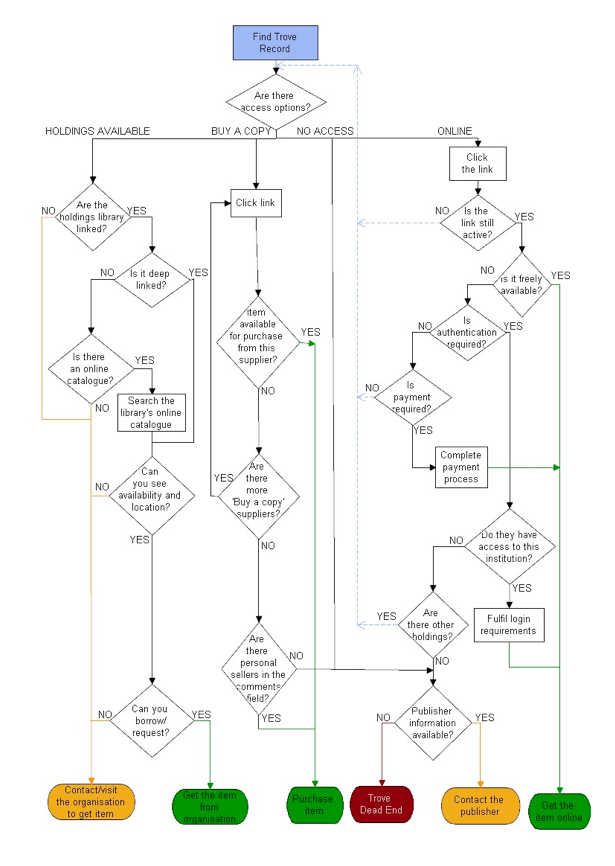 Figure 1: Flow Chart - 'Getting' Options in Trove 2010
Figure 1: Flow Chart - 'Getting' Options in Trove 2010
Although the Trove team can improve some 'getting' via improving the interface usability, a large responsibility still falls on contributing organisations who can facilitate deep linking between Trove and local catalogues, online order forms, and digitisation on demand. In 2010 OCLC's Katie Birch gave a relevant presentation on Trends and Developments in InterLibrary Loan and Document Delivery [4]. She reminded libraries that if we don't provide easy access, users will simply go elsewhere as cheaper and easier options emerge. It is important that libraries stay relevant and remain the first logical point of access for information, since after all, this is our main raison d'être. "In the old days the library was it-there weren't many other choices. Today, that is not the case." (2003 Environmental Scan).
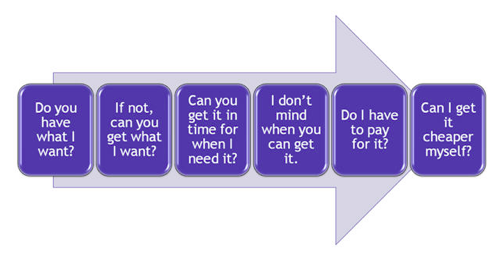 Figure 2: What matters to users. Katie Birch, OCLC presentation 2010
Figure 2: What matters to users. Katie Birch, OCLC presentation 2010
3. 'Get' Options Improved and Further Developed in Trove 2010-2011
3.1 Enrichment data
The 2009 Calhoun report found that metadata such as cover art, abstracts, table of contents, reviews, ratings, and comments help users decide which items to 'get'. This 'enrichment data' greatly helps the transition from 'find' to 'get'. Trove sources enrichment data from Amazon, Nielsen BookData, and Wikipedia and from its own users by giving them the ability to add tags, comments and ratings. It is not yet possible for users to add their own cover art as they can do in LibraryThing, but this would be very useful for out of print and unique items.
3.2 Unambiguously identify digital items
Many users are only interested in items that they can access immediately. Based on the information provided in catalogue or other metadata records, Trove mostly unambiguously identifies items that are available online. Three categories of "online-ness" have been identified with a fourth — 'samples' — which is currently in development. These categories are visible in the facets and highlighted on the brief results screen, facilitating direct access. A user can also limit searches to online items. The categories are not 100% accurate, but the rules can be modified based on feedback from contributors. The categories are:
Freely available: These items can be viewed online or downloaded by anyone. Copyright restrictions may still apply.
Access conditions: These items can be viewed online or downloaded, but one or more of the following conditions may apply:
- A one-off payment is required
- The item is restricted by subscription to particular university or library patrons
- There may be cultural sensitivity or rights requirements.
Unknown (Possibly available online): The item may or may not be available online. The link might lead to the full resource or to just a table of content, abstract or sample.
Sample (currently in development): The full item is not available online but a digital sample may exist e.g. music and video clips, abstract, first few pages of book.
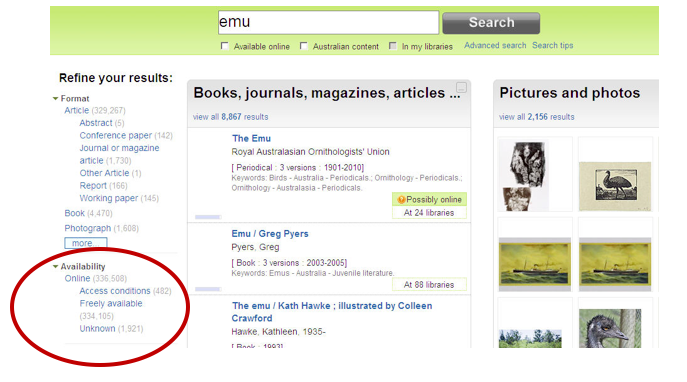 Figure 3: Online access options
Figure 3: Online access options
3.3 Design of interface — 'Get' screens
One of the greatest barriers to 'getting' is a poor user interface, resulting in users being unsure where they are, what they are looking at, or how to 'get' items. Since the release of Trove, an ongoing feedback process encourages users to report difficulties. It became apparent that most users found the search and results screens fairly intuitive but were confused when reaching the item/work/version level screens ('get' screens). A high volume of enquiries asking "I found this item, but I'm unsure how to get it - please help" confirmed this. Structured usability testing was undertaken to identify solutions for the 'getting' issues. The main issues identified with the 'get' screens:
Many users did not initially realise items have multiple 'get' options in different tabs inside an 'availability' box on the work and version level screens. The main 'get' option tabs are library holdings, online links, and purchase. Many users only saw the option on the tab which was open and did not move to other tabs. The tabs were renamed a few times to more accurately reflect the options. The list of institutions on the Australian libraries tab was frequently long and hard to narrow down. This tab was changed to view by state, and to collapse and expand the full list of holdings. Where the item is online, this tab is now displayed by default. For print-only items, the library tab is displayed by default, unless there are no library copies in which case the purchase tab opens. Changes to wording on the online tab more clearly separated the different online types.
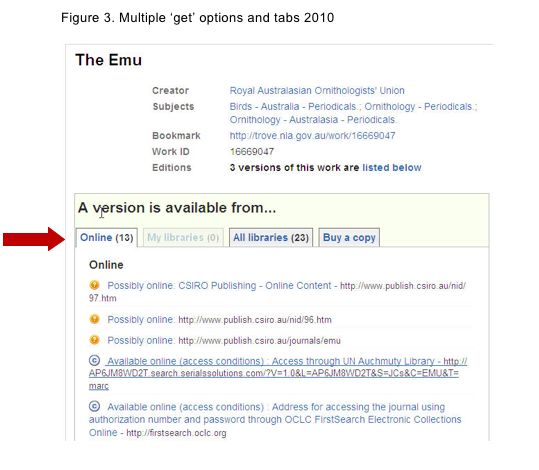 Figure 4: Online access options
Figure 4: Online access options
- Functional Requirements for Bibliographic Records (FRBR) - not understood, therefore 'get' screens not understood
Trove uses a concept of FRBR-like 'works', made up of editions/versions, grouping multiple items together across all formats, rather than displaying one record/one item as older-style catalogues do. Most users did not understand that there was both work and version parts of the screen with 'get' options, or the reasons for the different parts. Throughout 2010, users reported problems trying to 'find' and 'get' book versions based on language or date. While facets on the work screen should help this, usability testing showed most users ignored the facets, and did not understand their function. Substantial changes to facets and the work and version interfaces, including changing wording, font sizes, font colour, and placement of information, as well as collapsing/showing more information appeared to make a slight difference, however the core conceptual model of FRBR and the use of facets are still largely not understood. In late 2010, an advanced search was added to Trove. The advanced search did not offer any more functionality than already existed in Trove, but did offer a different way to drill down to an item without using facets. The team agreed a complete review of the 'get' screens and the effectiveness of the FRBR work/version display would be necessary in 2011.
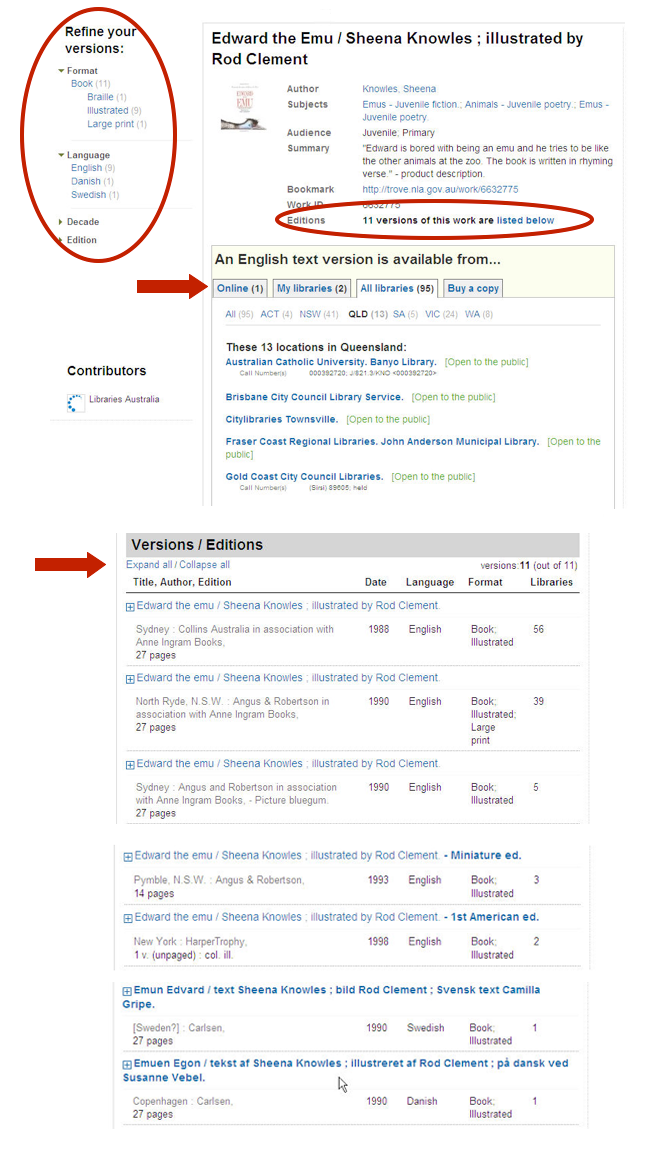 Figure 5: Work and version screen ('get' parts) 2010
Figure 5: Work and version screen ('get' parts) 2010
3.4 Show library names and which of these are open to the public
Key findings in the Calhoun 2009 report are "End users and librarians place a high priority on knowing where items are held and which are available immediately".
Over 1000 libraries contribute data to Trove via the Australian National Bibliographic Database (ANBD). It needs to be obvious to users where copies are held, since this information influences users 'get' decisions. Most library names are too long to display on the results screen. Trove uses the Australian Libraries Gateway (ALG) [5] to source library names. ALG entries are updated by libraries themselves. The Trove team added 'short library names' to the ALG to enable display on the Trove brief results screen. This received positive feedback from users. However, usability testing showed that users expected to be able to borrow from any library listed in Trove, but many libraries have access and borrowing restrictions. Trove was enhanced to use colour coding to display whether libraries are publicly accessible. The information is taken from ALG, and libraries can update it themselves. Wherever possible the relationship of branches to parent libraries is displayed.
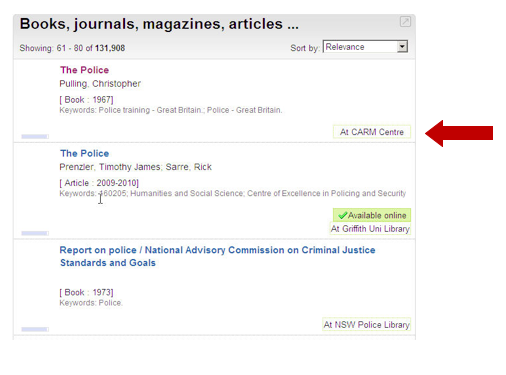 Figure 6: Short library names on results screen 2010
Figure 6: Short library names on results screen 2010
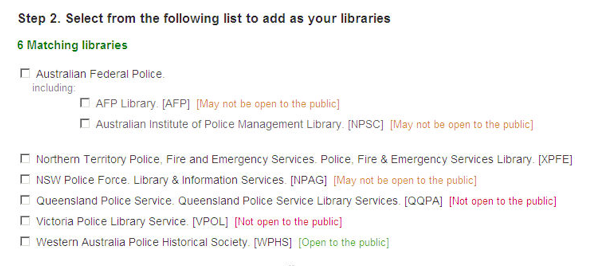 Figure 7: Access options for libraries 2010
Figure 7: Access options for libraries 2010
3.5 Finding libraries/organisations to add as your preferences
There is an option for a user to identify libraries which they would like to show in the tab 'my libraries' on the 'get' screen. This helps users get items fast from known institutions or ones they are affiliated with. The search of available libraries is keyword only and the user must know the actual library name (although the names of listed branch libraries will be searched as well as parent libraries). Usability testing showed that most people expected to be able to do a geographic name search. For example search on 'Canberra' or ACT and see all the libraries listed in that city/state (whether or not they had Canberra/ACT in the title), so that a user could select preferences after viewing the access conditions. A redevelopment of ALG will support this in 2011.
3.6 Alerting for Newspaper articles 'coming soon'
Trove contains millions of pages of digitised newspapers. Articles in this zone awaiting a final quality control check are shown in the results screens as 'coming soon' and likely to be available within 10 days. The citation and a snippet are displayed, but the article is not available. Many of these articles unfortunately fail the final quality check so are re-processed. This means the citation disappears and the article may not return to Trove for several months, which is very frustrating for users. With approximately 50,000 new articles appearing each week and very high usage of this zone, there was high demand for alerting users when the 'coming soon' articles were available. An RSS feed to alert users was implemented in mid 2010. However, the feed was inappropriate for articles that failed the quality assurance check and was therefore changed to a one-off email alert. This simple improvement had a major positive impact on the users 'getting' experience.
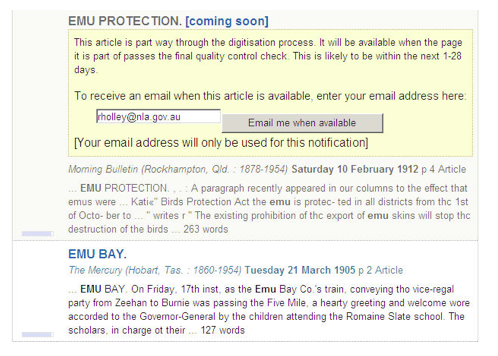 Figure 8: Alerting to new content — newspaper articles 2010
Figure 8: Alerting to new content — newspaper articles 2010
3.7 Purchase item
Where an item cannot be easily borrowed or viewed, some users will opt to buy a copy. It seemed logical to offer the option from the 'get' screen in Trove.
Any Australian bookshop that contacts the Trove team and has a web presence will be added to Trove, which currently lists 78 retailers. Where possible, Trove uses the ISBN to search the book-sellers online catalogue and link directly to the item on the buy tab. A link is also provided on that tab to a list of contact details for bookstores without searchable online catalogues, which may have that item.
Private individuals also contact Trove to ask about selling items - particularly academic or family or local history items - through the buy tab. We currently recommend using the 'comment' field to display such information. However, comments do not appear near the 'buy' tab, and are collapsed by default. Given the higher-than-expected contact from individuals wanting to sell their works a feature to support this will be implemented.
3.8 Purchase a copy of item (digital or physical)
The NLA offers a remote copying service (Copies Direct) [6] which is linked into Trove. It is heavily used to obtain digital or physical copies of a few book pages, an archive, manuscript or photograph at a fee. It can be used to obtain high resolution versions of freely available online items. If the NLA holds a copy of an item, the 'Copies Direct' button appears under the 'buy' tab in Trove. While initially Copies Direct was not available for digitised newspaper articles, it was enabled after demand was identified for:
- a high quality readable large print of a full page e.g. for a birthday present;
- the tiff file for use in publication/exhibition;
- 'missing pages' not digitised;
- a better/different copy of a poor quality page; and
- a page from a title that has not been digitised.
A National and State Libraries of Australasia (NSLA) Reimagining Libraries project will commence in 2011 to encourage each state and territory library to implement a remote copying service within the next two years. The State Library of Victoria implemented a remote copying service in December 2010. Such services can be integrated into Trove.
3.9 Access to authenticated resources for affiliated users
From October 2010 to June 2011, the Trove team is working on enhancements to allow online access to authenticated content in Trove as part of the Reimagining Libraries' Open Borders project coordinated through NSLA [7]. Most libraries in Australia subscribe to e-journals and databases. Trove is working with vendors to add metadata for this content and to allow patrons of their subscribers to seamlessly access it from Trove [8].
4. Ideas to Improve 'Getting' Options in Trove in the Future
It is essential to take a step back and look at the bigger 'get' picture. One of the most important things that users expect is unmediated online requesting. There are other things which can be done to improve 'getting' in Trove: both by the NLA and by Trove's other data contributors.
4.1 Deep linking to holdings of contributing libraries — Trove Contributors to take action
When a user follows a link to an external library from the work screen they expect to see that item's location and availability in the library's catalogue. This precise connection within a local catalogue - known as 'deep linking' — is dependent on cooperation between Trove and the library. Where libraries have not enabled deep linking, a user following the Trove link will either arrive at the catalogue search page or worse, at the library home page, at which point they will have to start their search again. At present only 20% of contributing libraries are deep linked. This leads to an inconsistent and negative 'get' experience for Trove users. This issue was a major finding of the usability testing carried out at the end of 2010. To help resolve it, Trove will continue to encourage libraries to enable deep linking, and will identify deep linked libraries more clearly from the work screen. Simple instructions for libraries to activate deep linking are available from the Libraries Australia website [9].
4.2 Granularity of holdings — Trove Contributors to take action
Users expect to see holdings for their local branch library. Some public library services do not list individual branches in ALG for various reasons and consequently users cannot see or select their local branch. It is important that contributing libraries realise the negative impact such decisions have on the users 'getting' experience in Trove.
4.3 Out of date holdings — Trove Contributors to take action
If libraries do not regularly update their holdings in the ANBD, particularly when items are removed from the collection, Trove's information will be incorrect. This has a negative impact on 'getting'. Although the same incorrect information appears in Libraries Australia the problem has come under the spotlight because of the high public usage of Trove. An active campaign targeting libraries that do not delete holdings from the ANBD has started. It has been suggested that the public should be able to mark libraries with unreliable information or records that were not available as they come across them. It is likely users would do this since generally they are motivated by wanting to help other people.
4.4 Items with no 'get' options — Trove Contributors or Trove team to take action
Items that have no 'get' options in Trove are very much a 'dead end' for users. It is very hard to identify items that have no 'get' options and the extent of the problem is not known. Items generally have no library holdings either because they have not yet been published, but have an initial 'pre-publication' record on the ANBD or are out of print items where all holding copies have been deleted by libraries. Ideas for improvement are:
- find a way to identify items with no 'get' options;
- delete or suppress items without a 'get' option from Trove/ANBD;
- appeal for users to find a 'get' option for the item;
- push it out as 'wanted' into the online space e.g. in Trove Forum/eBay/second hand bookshops/music stores etc;
- if item has not been published, show order information for locations, or add standard message 'coming soon' with alert; and
- link to LibraryThing and see if personal owners will lend/digitise copies.
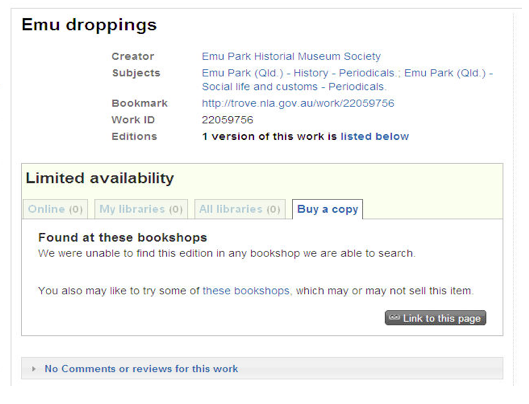 Figure 9: An item with no 'get' options i.e. a 'dead end' in Trove
Figure 9: An item with no 'get' options i.e. a 'dead end' in Trove
4.5 Broken links — Trove Contributors and/or Trove Team to take action
Many contributors do not use persistent identifiers to link to digital resources. Persistent identifiers tend to be more stable and reliable than other URLs. Broken links cause frustration and dead ends for Trove users. A sampling technique was used to try and find the extent of the problem. This showed that only 3-5% of the links to resources designated as 'free access' in Trove were broken. However, among resources designated 'possibly online', up to 50% had broken links. A sample check was also undertaken for the Australian Commonwealth Government Monographs and Serials in the NLA's catalogue as a comparison, which showed that 35-45% of links to these resources were broken.
Ideally, broken links need to be addressed at the source, but this raises other issues. For example, a broken link fixed in one ANBD record may be reintroduced if a copy record is reloaded from a local catalogue. Ideas for improvement are:
- encourage organisations to use persistent identifiers not URLs;
- regularly run a link checker over Trove/the Trove 'possibly online' category only and/or the ANBD to find broken links (would take months and the team cannot fix or delete the links);
- change the workflow of the ANBD to add a link checker to the workflow — stopping the addition of any broken links;
- change the workflow of the NLA Trove harvester to add a link checker to the workflow;
- identify contributors with a higher proportion of broken links in their records than others, and work with them to address the problem (these may be the libraries who submit the most records);
- send lists of broken links to record owners for fixing, if the owners and broken links can be identified; and
- add functionality to Trove so that users can correct, report or mark broken links.
4.6 Planned digitisation of regional newspapers and other content — Trove Contributors to take action
Trove's most heavily used content is the digitised newspapers. Every day the team receives requests from the public to digitise more newspapers, especially regional ones. The NLA has set up a national infrastructure to make this possible. At an approximate cost of $2 per page for microfilmed newspapers the NLA offers an end-to-end digitisation service [10]. Users would benefit if NSLA and public libraries funded such digitisation. It is essential for organisations to have planned digitisation programmes, especially for pictures and manuscripts, because this is by far the best 'get' option for all users.
4.7 Digitisation on Demand (DOD) — Trove Contributors to take action
Digitisation on demand services would allow the public to request individual items to be digitised (rights permissions allowing), and made available within a reasonable time period, online to all users at no cost. Currently, the National Archives is the only Australian public institution offering a DOD service [11].
4.8 Print on Demand (POD) — Trove Contributors to take action
Several years ago, user-driven print on demand capabilities (such as the Espresso Book Machine) were seen as being the answer to easily obtaining copies of out of print or limited print run editions. Most books were projected to cost about $3.00. POD was initially championed by book stores such as Angus & Robertson in Melbourne and universities. However retail POD has not taken off at all in Australia: the only public Espresso Machine was removed from Angus & Robertson's bookstore in January 2010. If any bookstore or library were to offer POD this could be made available as a 'getting' option in Trove.
4.9 Buy items other than books e.g. maps, music — Trove team to take action
It is often possible to assist purchasing of books in Trove because most recently published books have an International Standard Book Number (ISBN) which most booksellers also use to identify books. Initial efforts to expand purchase of items to CDs, DVDs, maps and scores has not been possible due the inconsistent application of unique identifying codes on these material types (e.g. ISMN, ISRC, ISAN), and lack of use of the codes by online retailers.
4.10 Buy digital books — Google eBookstore
One of the most exciting and dramatic 'get' options looming on the horizon for Trove users is the availability to purchase digital books via Google eBookstore. This is likely to change the information landscape considerably as other Google services have done. Since launch on 6 December 2010, 3 million of the 15 million digitised Google eBooks are available for purchase. Prices average around US$10. Google eBookstore is different to other e-book vendors for three reasons. Firstly Google will partner with booksellers to sell Google e-books; secondly the books are designed to be available on various devices, including laptops, smartphones, and tablets; and thirdly the books are stored 'in the cloud' (on Google servers) rather than on personal devices enabling them to potentially be re-formatted in the future and made available on any device type. The Google blog explains these significant differences clearly with an embedded video [12].
4.11 National, easy, unmediated, cheap, direct to door 'get' system (NEUCD)
A user's expectation of 'get-it' (or request item) in Trove already exists:
"I am registered in Trove; there will be a 'get-it' button on the 'get' screen for the item I want. This would send a request to a system behind the scenes to which all Trove contributors are connected — museums, archives, libraries and other places. The item would be found and sent to me at home. I wouldn't necessarily have to return it. I would be able to track progress of my item, and the system will be fast, cheap and reliable".
Many users are perplexed that this function does not already exist in Trove as inclusion seems logical. They cannot understand why it would be difficult to implement. If all libraries, archives and museums agreed and collaborated to help users 'get' what they want then it should be possible.
A pilot called 'Information Australia' in 2003-2005 tested self-initiation of inter-library-loan (ILL) through a national unified library catalogue. Although the system worked in this limited trial, it did not take-off because libraries were reluctant to commit to the costs associated with very large scale ILL and because it did not fully meet user expectations. The evaluation report [13] says:
"Users identified a number of areas in which the service could be developed to be more effective. The complex process and lack of automated confirmation and regular automatic updates was frustrating. Worse however was the frustration of ordering and not promptly receiving material. All user groups expressed a reluctance to pay for interlibrary loans — though when pushed they indicated that charges in the region of $2 to $10 might be paid."
Nevertheless the pilot led to the feature (enhanced requesting) being implemented in the new 'Libraries Australia' in 2005. Currently only 167 libraries out of 1000 have the feature activated. It would be possible in Trove to replicate this feature based on the current mediated ILL system. However there would be budget implications for libraries if there was a large uptake by users, the current system does not have online user tracking, is relatively expensive, not always timely for the user, and is limited to library resources. Following this pilot in 2005-2006 there was much discussion and interest in re-thinking resource sharing both in Australia and internationally. At this time the Rethinking Resource Sharing Initiative [14] was formed in the USA. It created a Manifesto for Resource Sharing with seven key principles [15].
This inspired other articles and presentations of significance such as those by the NLA's Kent Fitch (system architect of Trove and Australian Newspapers) [16, 17] and Judith Pearce [18], and OCLC's Janifer Gatenby [19]. They addressed the urgent need for libraries to develop collaborative service models for unmediated seamless delivery, therefore solving 'dead end' issues for users.
Unfortunately, since 2006 no further national developments have taken place for NEUCD. The advent of Trove re-opened these discussions with new vigour, since Trove could be used as the vehicle for offering the NEUCD 'get' option. It is not essential that Trove is the NEUCD mechanism itself, but it could be a seamless gateway to the any NEUCD system. Trove offers a fantastic opportunity to progress some of the 2006 ideas.
Based on what we know about existing ILL and document delivery processes it would not be effective to tap into existing workflows and systems, but instead necessary to look at 'get-it' requirements with fresh eyes and develop a new system firmly focused on user needs. Kim Baker, Chair of the IFLA Document Delivery & Resource Sharing Standing Committee stated in her 2007 presentation about the Initiative:
"Libraries need to stop looking at designing processes and systems to suit librarians — they need to adapt and modify their processes and systems to suit the user. This new paradigm thus STARTS with the user, and not the other way around."
The University of Pennsylvania has demonstrated that achieving such a service is both feasible and possible (Borrow Direct), and Robert Krall gave a presentation at the ALIA September 2010 Conference outlining how this had been achieved [20].
5. Conclusion
Improving 'getting' for Australians requires a multifarious approach, utilising several different techniques and options to best meet user needs and expectations. In 2010 the Trove team has worked hard to improve 'getting' and identify more 'get' options, but there is still a long way to go. Not all of the responsibility of 'getting' rests with the NLA, much rests with Trove contributors — libraries, archives and museums of Australia, who hold the resources. There is a need to work collaboratively. Contributors ideally need digitisation programs in place, deep linking support, online order forms, and up-to-date granular records.
It is clear that users want a seamless transition from 'find' to 'get' and Trove is the place to achieve this. The two 'get' options that are most desirable to the user are firstly full digitisation of items, (especially newspapers), that are then freely downloadable and viewable; and secondly a national system (which does not yet exist), that is fast, reliable and cheap, enabling them to 'get-it' by simply clicking a button in Trove and then being able to order, track and receive a physical item direct to their door. To achieve this requires taking a step back and looking at the picture from a user's viewpoint, not a library processes viewpoint.
Trove has demonstrated that it is possible and feasible to implement an exemplary Australian discovery service that meets the needs of users. It follows that it is also possible to implement a national exemplary 'get' service seamless within Trove. We need to overcome the perceived difficulties, have faith in ourselves and rise to action. Australia has a fantastic opportunity now to demonstrate to the information world and our public at large that we can deliver on both 'find' and 'get' better than anyone else.
6. Notes
An accompanying PowerPoint presentation goes with this paper, which is available at http://www.slideshare.net/RHmarvellous.
7. References
[1] Holley, R. (2010) Innovation in Information Access in Australia. In Ariadne, issue 64, July 2010.
[2] Calhoun, K. et al (2009) Online Catalogs: What Users and Librarians Want: An OCLC report.
[3] De Rosa, C., Dempsey, L., Wilson, A. (2003) Environmental scan: Pattern Recognition. An OCLC report.
[4] Birch, K. (2010) Trends and Developments in Inter-Library Loan and Document Delivery. OCLC Research. Presentation at Libraries Australia Forum, October 2010.
[5] Australian Libraries Gateway.
[6] Copies Direct.
[7] National and State Libraries of Australasia (2010) Reimagining Libraries' Open Borders Project.
[8] (2010) Trove Stage 4 - Journal articles and E-resources - scope. 1 November 2010.
[9] (2010) Deep linking for libraries - instructions on how to set up.
[10] Australian Newspapers Digitisation Program (2010). Contributing to the Australian Newspapers service and Guidelines for libraries contributing content to the Australian Newspapers service.
[11] The National Archives Digitisation Service. Fact sheet 249.
[12] The official Google blog (2010) Discover more than 3 million Google eBooks from your choice of booksellers and devices. 6 December 2010.
[13] Missingham, R. (2005) Evaluating the Public Library Portal. (Information Australia).
[14] (2006) Re-thinking Resource Sharing Initiative website.
[15] Rethinking Resource Sharing (2005) A manifesto for re-thinking resource sharing.
[16] Fitch, K. (2006) Expanding the borrowing options for Australians: A proposal to provide rapid and easy access to the wealth of information resources that reside in libraries. Presentation at Resource Sharing Consultation Forum, NLA, 18 May 2006.
[17] Fitch, K (2006) A new paradigm for 'getting': a proposal to improve access to the information resources of libraries. Presentation at Libraries Australia Forum 3 November 2006.
[18] Pearce, J & Gatenby, J (2005) New Frameworks for Resource Discovery and Delivery.
[19] Gatenby, J (2006) Today's information consumer tapping into international library services: making it a reality.
[20] Krall, R (2010) Rethinking Direct Borrowing Services in a Consortium: Experiences, Challenges, and Opportunities, University of Pennsylvania Libraries, USA. Presentation at ALIA Access Conference, Brisbane, September 2010.
About the Author
 |
Rose Holley has worked in libraries and archives in the UK, New Zealand and Australia. She is a digital library specialist and has managed a number of significant collaborative digitisation projects over the last 10 years, including the Australian Newspapers Digitisation Program. She now focuses on delivery of digital content to users, creating systems that enable social interaction and engagement with content. Rose is Manager of Trove, the single discovery service for Australia based at the National Library of Australia. She has a particular interest in using crowdsourcing strategies to help improve access to library and archive collections, and in harnessing the knowledge, expertise and enthusiasm of volunteers.
|
|